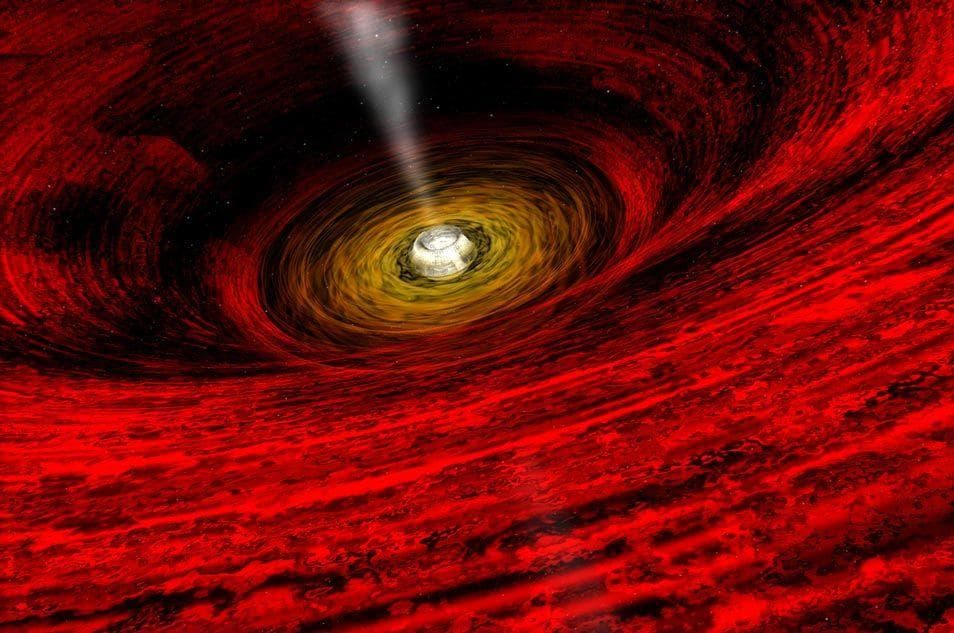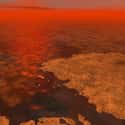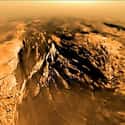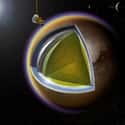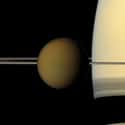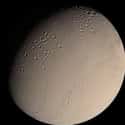-
(#1) It's Like A Primordial Earth
Titan is often described as a primordial Earth, where processes such as flowing liquids and organic compounds point to the potential for life. However, much like Earth's earliest days, Titan isn’t currently hospitable to humans.
The moon's frigid temperatures, low ultraviolet surface exposure, and lack of liquid water and breathable air mean that complex organisms wouldn’t be able to survive there for very long without the aid of technology.
-
(#2) It Has A Dense Atmosphere
Titan is the only moon in the solar system with a robust atmosphere. Primarily comprised of nitrogen (approximately 95%, compared to Earth’s 78%) and methane (approximately 5%, compared to less than .01% on Earth) with trace amounts of other compounds mixed in, Titan has an even denser atmosphere than Earth. The moon’s atmosphere also extends 10 times higher into space than Earth’s at 370 miles, due to the moon’s lower gravity,
Titan’s hazy, orange aura is thought to be caused by ultraviolet light from the sun splitting nitrogen and methane molecules high up in the atmosphere. A competing theory suggests that rather than a photochemical reaction, Saturn’s strong magnetic field may actually cause the divisions. Regardless of its catalyst, the splitting phenomena creates organic molecules, such as carbon, hydrogen, and oxygen, which are some of the foundational elements necessary for life.
-
(#3) It Doesn't Have A Magnetic Field
A distinct difference between Titan and Earth is that Titan doesn’t have a significant magnetic field, if any at all. Instead, the moon exists at the edge of Saturn’s massive magnetosphere, where it's sometimes protected from, and sometimes exposed to, the sun's solar winds.
-
(#4) It's Really, Really Cold
At -290 degrees Fahrenheit (-179 degrees Celsius), Titan is unbearably cold. The moon does get some slight warmth from a greenhouse effect created by atmospheric methane. However, this effect is negated as compounds in the upper atmosphere reflect light back into space, contributing to a less powerful, but nonetheless consequential, anti-greenhouse effect. The lack of ultraviolet penetration also means that Titan’s uppermost atmosphere is much warmer than the moon’s surface, which only receives 0.1% as much light as people do on Earth.
Despite the ever-present cold, Titan does experience seasons. It also has a similar hydrological cycle to Earth, where methane, instead of water, evaporates into the atmosphere and pours down as rain. Winds are also prevalent on Titan, and have been measured at speeds of 270 miles per hour.
-
(#5) It Has Lakes And Seas
Besides Earth, Titan is the only known body in the solar system with stable bodies of liquid on its surface. Titan’s landscape is littered with various lakes and seas, mainly composed of methane and ethane.
Those compounds can exist in liquid form there due to the extreme cold.
-
(#6) Its Surface Is Constantly Reshaped By Ice Volcanoes
Titan’s surface is composed of 50% rocky material and 50% water-ice. Though its average surface height seldom varies more than 150 meters, some taller mountains have been detected. Granular dunes of frozen hydrocarbon cover different areas of the moon, while methane-spewing cryovolcanoes and fluctuating bodes of liquid are thought to constantly reshape the surface.
Liquid water and ammonia, also believed to be emitted from subsurface activities, form “lava flows” along the surface, solidifying into various frozen features and contributing to the moon’s evolving landscape.
-
(#7) It Doesn't Have Many Craters
With an ever-changing surface, it’s hard to know how often Titan has been impacted by asteroids or meteors. Since the moon is the size of a small planet, it's likely to have been hit by space debris, though only a few impact sites have been definitively identified.
But as it orbits the solar system’s second largest planet, Titan may be saved from many impacts; Saturn’s immense gravity likely draws in the bulk of passing objects.
-
(#8) It Might Have A Giant Subterranean Ocean
Titan is thought to have a slightly slushy core comprised of rock and ice. But its inner body might also be encircled by a vast subterranean ocean. It’s fun to speculate what might exist in the depths below Titan’s icy surface but, with limited data, scientists can’t yet make detailed predictions about the hypothetical ocean.
Still, the prospect of an underground body of water with volcanic activity raises some researchers' hopes for the potential of extraterrestrial life there.
-
(#9) It Could Theoretically Support Life
Life on Earth is thought to have begun in the oceans, and similar hypotheses surround Titan’s subterraneous and surface liquids. Scientists are also looking at the unusual ways in which life could emerge under Titan’s unique molecular and environmental conditions.
Computer modeling of methane-based life has suggested that such a phenomena is possible, though no physical tests have been attempted to date.
-
(#10) It's Bigger Than Mercury
With a surface diameter of approximately 3,201 miles, Titan is the second-largest moon in the solar system, after Jupiter's Ganymede. Titan is 50% bigger than Earth’s moon, and is larger than the planet Mercury.
-
(#11) It Might Be Older Than Saturn
Astronomers aren’t exactly sure how Titan formed, but it doesn't appear to be an amalgam of smaller remains like so many of Saturn’s other orbiting bodies. One theory suggests that Titan could actually be older than Saturn - a rarity for a moon’s relationship to its host planet.
-
(#12) It's Tidally Locked
Titan is tidally locked to Saturn, constantly showing only one side of itself as it orbits at a distance of 759,000 miles. It takes 15 days and 22 hours for Titan to complete its journey around the massive planet, where it exists in orbital resonance with another one of Saturn’s moons, Hyperion.
-
(#13) It's Been Explored
Humans first visited Titan’s region of space in 1979 with the Pioneer 11 probe. The mission reported that Titan was too cold to support life. Voyager 1 observed Titan by flyby in 1980, and while measurements such as mass, density, and surface temperature were obtained, the moon’s orange haze made it difficult to capture images of the surface.
Decades later, the European Space Agency (ESA) and NASA collaborated on the Cassini-Huygens mission, which completed its first flyby of Titan on December 13, 2004. Cassini mapped Titan’s surface by radar, and was able to capture the first high-resolution images of the mystery world.
Cassini deployed the Huygens probe, and it landed on Titan on January 14, 2005. It parachuted to a shoreline, where it used a variety of instruments to try to decrypt Titan’s many surface anomalies. Huygens was able to collect data for approximately 90 minutes, sending some 350 photographs back to Earth.
Cassini's last flyby of Titan is scheduled for April 22, 2017, and the probe's journey ends with a dive into Saturn. But a number of proposals to further explore Titan have already been proposed by ESA, NASA, and JPL, as well as by private companies and individual scientists. Everybody seems to be interested in unraveling the mysteries of this exotic world to see if life is actually possible there.
-
(#14) It's Hard To Visit
Titan is approximately 746 million miles away from Earth when the two bodies are at their closest. Compare that to Mars, which measured 34.8 million miles away at its record-setting closest point, and which humans are just now contemplating human travel to. In other words, travel to Titan presents something of an advanced engineering problem.
To date, the fastest Earthlings have been able to get a lightweight probe to Titan’s locale is two years and four months, meaning that faster and more powerful engines will be necessary before humans can visit themselves.
-
(#15) Its Neighbors Are Fascinating Too
Saturn has 62 known moons, though most are small. Still, moons like Enceladus, with its subterranean ocean and spewing geysers, are fascinating places that, like Titan, are also being studied as potentially life-harboring worlds.
-
(#16) It Can't Host People For A Long, Long Time
Making a home on Titan could take a bit of time - four billion years, give or take a few hundred million. That’s when the sun will become a red giant, thereby warming Titan and potentially allowing for liquid water to emerge on the moon. Those conditions could then create indigenous life, and potentially better support humans as well.
It’s certainly a long ways off but, on the bright side, it gives people plenty of time to pack.
New Random Displays Display All By Ranking
About This Tool
Titan is the largest moon orbiting Saturn and the second-largest moon in the solar system. The Dutch physicist and astronomer discovered it in 1655. Titan is currently the only known satellite in the solar system that has a liquid ocean. According to data returned by space probes, Titan’s atmosphere is dominated by nitrogen. Apart from the earth, no second satellite has been found with this characteristic.
Human beings have reasons to believe that Titan is the second celestial body besides the earth that is most suitable for human existence. Titan, like the earth, can rotate to produce seasonal changes, but its seasons last about 7 years. The random tool introduced more facts about Saturn's Moon Titan.
Our data comes from Ranker, If you want to participate in the ranking of items displayed on this page, please click here.


